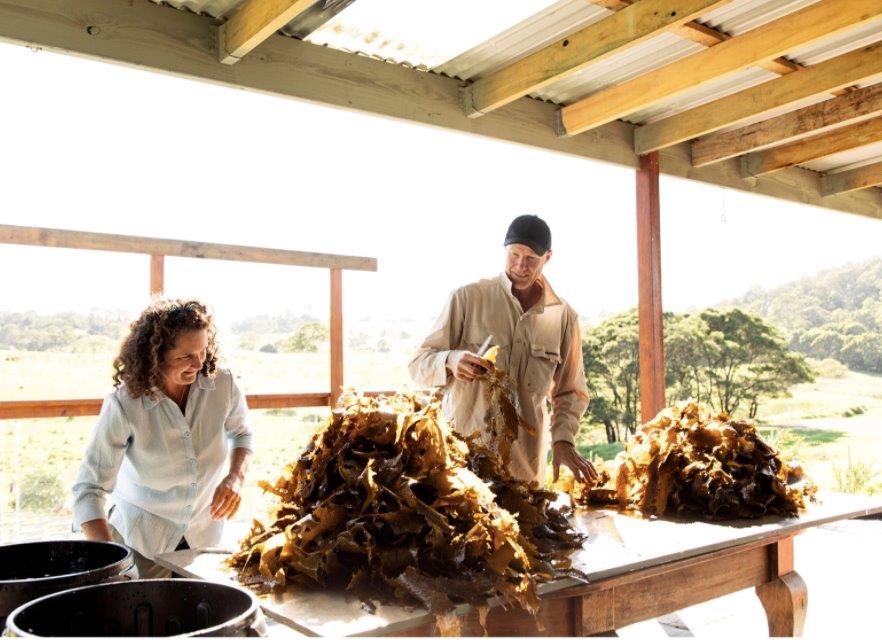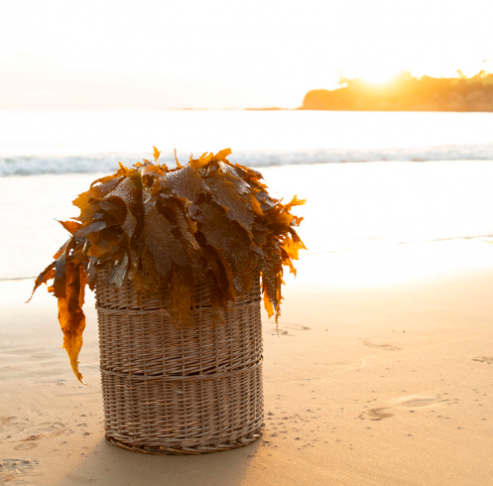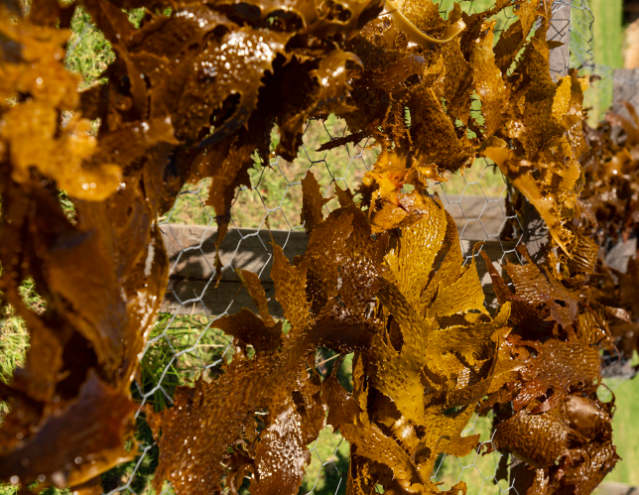A study in 2018 asked one question: is Australian seaweed worth eating? The answer is multipronged. You see, local seaweed products are hard to come by as the industry is micro: there are just a handful of producers operating across the country.
Most consumers would never have tried an Australian seaweed product, with the majority imported from China, Korea or Japan.
The Nutritional and sensorial properties of wild-harvested Australian versus commercially available seaweeds report compared nine Australian wild-harvested
seaweeds including Laurencia filiformis (red algae), Codium galeatum (green algae) and Cystophora torulosa (brown algae) to four of the most prolific international species: Pyropia tenera (nori), Sargassum fusiforme (hijiki), Saccharina angustata (brown algae) and Undaria pinnatifida (wakame).
The study revealed some interesting finds: four Australian species had higher total lipids than all commercial products in the study and some of the highest values reported in seaweed literature. As part of the study, seaweeds were served as a soup or salad. There was no consumer difference when the seaweed was presented in soup form, however hijiki reigned supreme when it came to salad preparation.
It’s estimated there are more than 3,000 native seaweed species in Australia, which indicates one thing — potential.
Hospitality speaks to Jo Lane from Sea Health Products about her work foraging brown algae by hand and Chef Joel Bennetts from Fish Shop about how he’s using various forms of seaweed at the Bondi restaurant.
The producer

Jo Lane took over Sea Health Products from Betty Long, who handed over her ‘kelp
lady’ baton in 2015. Lane has a background in marine science and sustainable coastal environments, and secured the Churchill Fellowship in 2019, which saw her travel across Europe, Asia, North America and Canada to visit kelp farms.
Seaweed farming is a new industry in Australia and is very much in its infancy. “I would say we’re in the early stages,” Lane explains. “Seaweed isn’t a traditional part of our culture or our Western diet. There is demand because we do import a lot of products, but we haven’t done the research on the lifecycle of our unique species.
“Korea, Japan and China have big aquaculture industries that have been going for more than 70 years, so they have a real understanding of the lifecycle of seaweeds.”
Lane hand harvests kelp on the South Coast of New South Wales. “It’s a hardy species and it’s a brown kelp that has lots of nutritional benefits,” she says. “However, it is difficult to grow as we are finding.” Lane collects fresh kelp as it comes in from the tide. The kelp has usually been dislodged from storms as it cannot be cut or removed from the source.
“The way we do it is very sustainable, and that’s my big motivation,” says Lane. Once the kelp is collected, it’s washed in rain or mountain water and left to dry in the sun. After it has dried, the seaweed is typically milled into a granulated consistency or a powder. “There is more demand, and it’s hard to keep up with that in the way we currently operate,” says Lane. “Harvesting can only get us to a certain capacity.”

There are around 3,000 native seaweeds in Australia, with a significant number only found in our waters. Lane says there is a whole world of potential when it comes to farming — it just comes down to research. “There are red, brown and green seaweeds and they all have different nutritional qualities and tastes,” she says.
“We don’t fully understand how to grow them and that’s what I’m really keen to explore. We are working with universities on the breeding side of things and getting to the stage of farming, which will give us consistent supply. From a small number of plants, we can release millions of spores and seed hectares.”
While brown kelp is Lane’s bread and butter, she’s also managed to get her hands on limited amounts of bull kelp, which is comparable to konbu. “Konbu is a particular species, but we have a number of seaweeds in Australia that are more like a strap; you get that in Tasmania,” she says.
“Chefs’ eyes light up when you have it; it’s that umami.” Lane has worked with a number of chefs who use her products in different ways from pickling to seasoning. “Kelp is such a versatile product; what led me to study farming was the fact that there are so many things you can do with seaweed that I can’t physically collect enough of it for what I want to do,” she says.
“When I talked to farmers in Asia, it made me want to achieve this goal in Australia for the environmental benefits it can bring. Farming is a way of creating habitat, it absorbs carbon and it creates a resource. Potentially we can grow an industry here, which is very exciting.”
The chef

Joel Bennetts first started cooking with seaweed 10 years ago, but his memory goes back a little further. “When I was young, I always noticed how the weeds would dry and rehydrate as the tides changed,” he says. “I remembered this when I became a chef and realised the potential of it in the food I created.”
Bennetts worked in Japan and it was here where he incorporated seaweed into his culinary repertoire. “In Japan, I would use seaweed for a vegan vegetable dish I created, toasting fresh seaweed over the charcoal to create flavours that would permeate the vegetable.”
It’s indicative of one dish diners — and Bennetts — “froth” at Fish Shop in Bondi. While the chef goes hard and fast when it comes to the majority of menu items (“It’s just how I do stuff,” he says), this particular dish isn’t going anywhere. “We sell 20−30 of the cabbage with nori dressing per day; every person is blown away that it’s vegan and made out of seaweed,” he says.
“It has ginger and shallot inspired by Cantonese cuisine and a rice wine vinegar, sesame and mirin dressing with the nori tying it all together.”

Seaweed has always been an accessible ingredient for the chef, who harvests along the eastern and northern beaches of Sydney when he gets the chance. Otherwise, he sources products from Two Providores, which supplies local and imported options.
Bennetts uses everything from Tasmanian wakame to konbu, laver and nori as “there’s always stuff going on with seaweed” at the restaurant. “Seaweed is a staple in my dry store, it’s versatile and it’s forgiving,” he says.
Local products, in particular, come at a higher price than those that are imported; a given due to the micro industry here. But it’s far from a deal breaker. “It’s not cheap, but it has maximum yield,” says Bennetts. “You can use a teaspoon of wakame and it bombards you with umami and sea. It’s like a sponge — it’s dry and porous but as soon as you bring it to moisture, you’re getting double or triple the yield. In a restaurant sense, the amount you need versus the flavour you get is quite large.”
As far as culinary applications go, seaweed is incredibly versatile. Bennetts would use powdered nori over salad, a sheet for the base of a sauce and a purée “because it has a heavier flavour” and wakame and smaller seaweeds for salt or in a soup.
The chef recently ran a seaweed spin on a café de Paris butter. “The basis of the dish was Japanese flavours and the coral trout has a delicate flavour, so I didn’t want to overpower it,” says Bennetts. “I softened butter and put eschallots, blended wakame, nori and yuzu kosho paste with black pepper and sea salt. I set it in the fridge and it melted from the heat of the fish.”
Most diners have likely consumed seaweed in sushi form (hello, sushi train), but terms such as laver and wakame are not familiar to all. At Fish Shop, dishes don’t just reference seaweed, but the exact variety. “I think it’s important to call it by the correct term,” says Bennetts.
“Nori is well known compared to wakame or laver (two years ago, I was asking what laver was), but it’s a quick education. Wakame might not stand out as much as a salsa verde or a tartare sauce on the menu, but we’re in a position to educate people with the knowledge of our staff and bring them in to try new things.
“If we’re trying to make seaweed a more common ingredient, why would you just call it seaweed? It’s an amazing product we’re lucky enough to have ease of access to.”

